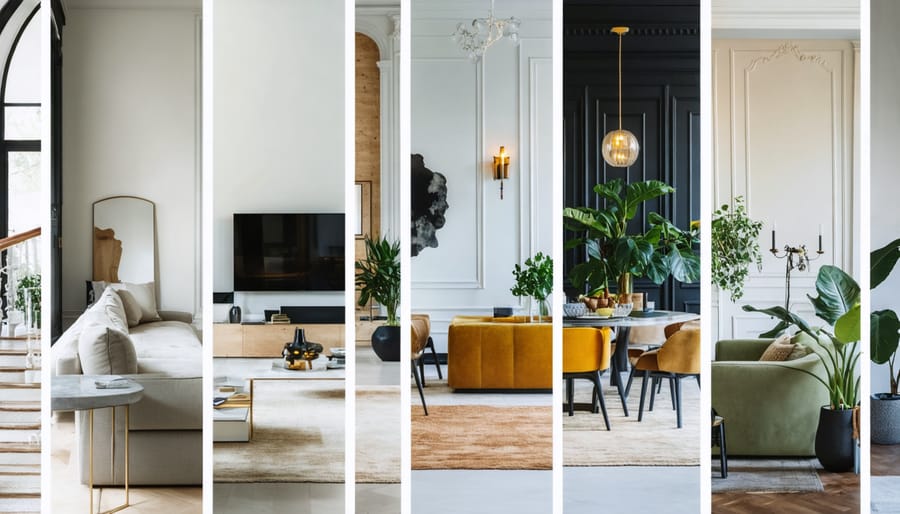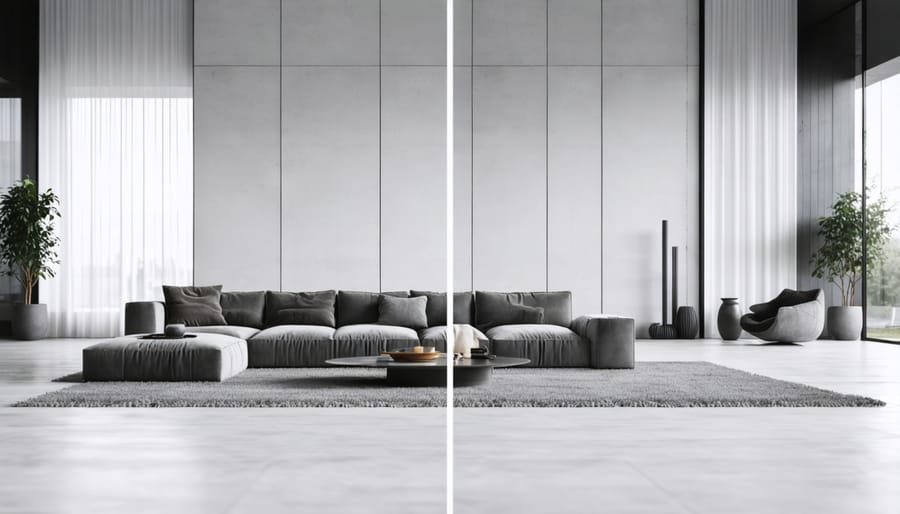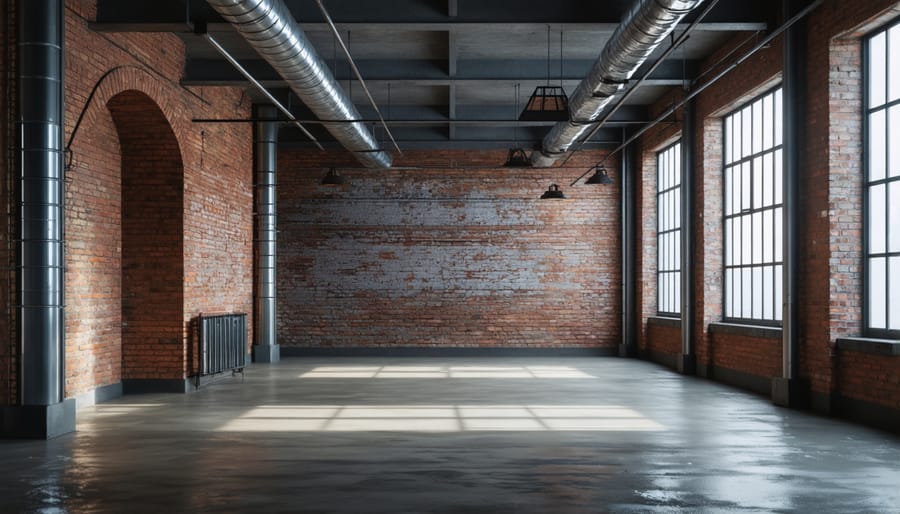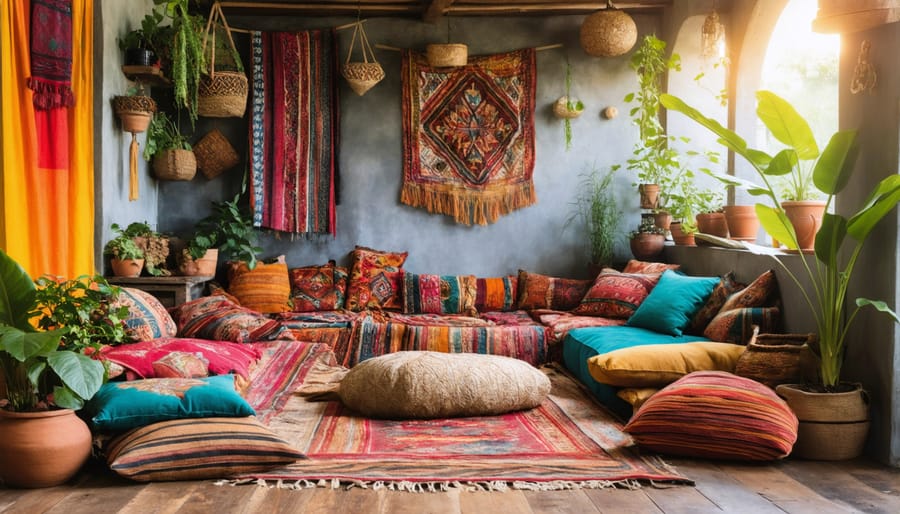
These Interior Design Styles Transform Any Room (See Which Fits Your Home)
Transform your living space into a personal sanctuary by exploring the seven distinct interior design styles that have shaped modern homes. From the clean lines of Scandinavian minimalism to the bold patterns of maximalist design, each style offers unique ways to express your personality through your living space. Whether you’re planning a complete home makeover or simply refreshing a room, understanding these fundamental design approaches will help you create spaces that both inspire and function beautifully.
Today’s interior design isn’t just about aesthetics – it’s about creating environments that enhance our daily lives. Modern homeowners mix and match elements from different styles, breaking traditional rules to craft spaces that truly reflect their lifestyles. These seven distinct approaches to interior design serve as your foundation, offering tried-and-true principles that can be adapted to any home, budget, or personal taste.
Let’s explore how each style can transform your space, incorporating both timeless elements and contemporary trends that make your home uniquely yours.
Modern Interior Design: Clean Lines and Minimalism

Key Elements of Modern Design
Modern interior design embraces clean lines, simple forms, and a “less is more” philosophy. This approach, which often overlaps with minimalist interior design styles, emphasizes functionality without sacrificing style. Key elements include open floor plans, neutral color palettes with occasional bold accents, and the strategic use of natural light.
Materials play a crucial role, with modern designs favoring glass, steel, and polished surfaces. Furniture typically features straight lines and geometric shapes, often raised on legs to create a sense of space and airiness. Technology integration is seamless, with smart home features discreetly incorporated into the overall design.
Texture comes from natural materials like wood and stone, while decorative elements are carefully curated and purposeful. Walls are usually kept simple, either in solid colors or featuring large-scale abstract art pieces. The overall effect creates a sophisticated, uncluttered space that feels both contemporary and timeless.
How to Achieve Modern Style
To achieve a modern interior design style, start by embracing clean lines and minimalism. Remove unnecessary decorative elements and opt for furniture with simple, geometric shapes. Choose a neutral color palette dominated by whites, grays, and blacks, then add strategic pops of bold color through artwork or accent pieces.
Incorporate materials like glass, metal, and polished stone to create sleek surfaces that reflect light. Large windows without heavy draping help maintain an open, airy feel while connecting indoor spaces with the outside world. Select furniture that sits low to the ground and features exposed legs to create a sense of space.
For lighting, choose fixtures with clean metallic finishes and geometric shapes. Consider recessed lighting or track systems for a streamlined look. Keep accessories minimal but impactful – think large abstract art pieces or a single striking sculpture. Organization is key, so invest in hidden storage solutions to maintain clutter-free surfaces, essential for the modern aesthetic.
Traditional Design: Timeless Elegance
Traditional Design Elements
Traditional interior design celebrates timeless elegance and symmetry, drawing inspiration from 18th and 19th-century European décor. This style features rich wood tones, elegant curved lines, and matched pairs in furniture and accessories. You’ll find ornate details like crown molding, wainscoting, and classic architectural elements throughout traditionally designed spaces.
The color palette typically includes warm neutrals, deep jewel tones, and subtle patterns. Furniture pieces are often substantial and well-crafted, featuring carved details and luxurious upholstery in materials like silk, velvet, and leather. Traditional rooms commonly showcase antique pieces, fine art, and classic patterns such as damask, stripes, and florals.
Accessories play a crucial role, with crystal chandeliers, gilded mirrors, and carefully curated collections of china or silver. Window treatments are formal and layered, often combining sheers with heavier drapes. The overall effect is sophisticated and comfortable, creating spaces that feel both elegant and welcoming.
Implementing Traditional Style
To create a traditional interior design style, start by establishing a cohesive color scheme using warm, rich tones like deep reds, browns, and golds. Choose furniture with curved lines and ornate details, focusing on symmetrical arrangements that create a balanced, formal atmosphere. Incorporate classic patterns such as damask, stripes, or florals through upholstery and window treatments.
Layer your lighting with a mix of table lamps, wall sconces, and an elegant chandelier as a focal point. Add architectural details like crown molding, wainscoting, or chair rails to enhance the traditional feel. Accessorize with antique pieces, oil paintings in gilded frames, and classic table accessories like silver candlesticks or porcelain vases.
For window treatments, opt for floor-length drapes with valances or swags. Complete the look with plush area rugs featuring traditional patterns and a rich color palette that ties the room together. Remember to maintain clean lines and avoid cluttering the space, as traditional design emphasizes refined elegance rather than excess.
Contemporary Style: Today’s Trends
Contemporary Design Features
Contemporary design continues to evolve with current design trends favoring clean lines, open spaces, and a perfect balance between comfort and sophistication. Key features include large windows that maximize natural light, neutral color palettes punctuated by bold accent pieces, and smart home technology integration. Furniture typically showcases simple forms with minimal ornamentation, often featuring materials like glass, metal, and sustainable woods. The style emphasizes clutter-free environments with strategic storage solutions and multi-functional pieces. Statement lighting fixtures serve as artistic focal points, while natural elements like indoor plants add organic touches to the sleek aesthetic. Texture plays a crucial role through layered textiles, geometric patterns, and mixed materials, creating visual interest without overwhelming the space. Contemporary design particularly excels at incorporating eco-friendly materials and energy-efficient solutions, making it both stylish and sustainable for modern living.
Creating Contemporary Spaces
To create a contemporary space, start with a neutral color palette featuring whites, grays, and blacks, then add strategic pops of bold color through artwork or accessories. Focus on clean lines and uncluttered spaces by selecting furniture with simple, geometric shapes and minimal ornamentation. Incorporate natural materials like wood and stone, but mix them with modern elements such as glass and metal for balance.
Lighting plays a crucial role in contemporary design. Install a combination of recessed lighting and statement fixtures with sleek designs. Large windows should be dressed minimally to maximize natural light and create an indoor-outdoor connection.
Technology integration is essential – consider hidden charging stations, smart home features, and wireless solutions that maintain the clean aesthetic. Choose art pieces that make bold statements while maintaining simplicity, and remember that in contemporary design, negative space is just as important as the elements you add. Keep accessories minimal but impactful, focusing on quality over quantity.
Industrial Design: Urban Sophistication

Industrial Style Elements
Industrial style celebrates raw architectural elements and mechanical features, transforming them into bold design statements. Exposed brick walls, concrete floors, and visible ductwork create an authentic foundation, while metal fixtures and steel beams add structural interest. The style embraces weathered wood, particularly reclaimed pieces that tell a story through their patina and wear.
Signature elements include Edison bulb lighting, factory-style windows, and open shelving made from pipes and wood. The color palette typically features neutrals like grays, blacks, and browns, often accented by metallic finishes in copper, brass, or steel. Large, open spaces with high ceilings are particularly suited to this style, though industrial elements can be incorporated into any space.
Furniture pieces often combine metal and wood, featuring clean lines and utilitarian designs. Look for vintage factory carts, metal filing cabinets, and workshop stools to add authentic industrial character. The key is to balance raw materials with comfortable textiles to create a livable, yet distinctly urban atmosphere.
Achieving Industrial Aesthetic
To achieve an authentic industrial aesthetic, start by embracing raw materials like exposed brick, concrete, and metal finishes. Strip back walls to reveal underlying materials or use textured wallpaper that mimics industrial surfaces. Install statement lighting with metal finishes, especially pendant lights with cage designs or Edison bulbs. Open ductwork and pipes can become design features rather than eyesores – consider leaving them exposed and painting them in metallic tones.
Incorporate weathered wood elements through reclaimed furniture or accent walls. Metal pipe shelving and steel-framed furniture add authentic industrial character while remaining functional. Keep the color palette neutral with grays, browns, and blacks, punctuated by metallic accents.
For a softer industrial feel, balance harsh elements with plush textiles and warm lighting. Add vintage factory pieces like metal signs, old machinery parts, or industrial carts as decorative elements. Remember, the key is to maintain an open, spacious feel while celebrating the raw, utilitarian nature of industrial spaces.
Scandinavian Style: Functional Beauty
Scandinavian Design Principles
Scandinavian design embraces the philosophy of “less is more,” combining functionality with clean aesthetics and natural elements. This style emerged from Nordic countries, where long winters influenced the need for bright, airy spaces that maximize natural light. The core principles include minimalism, neutral color palettes (predominantly white, gray, and beige), and the liberal use of natural materials like wood, especially light varieties such as pine and birch.
What sets Scandinavian design apart is its focus on creating hygge – a Danish concept of coziness and comfortable conviviality. This is achieved through layered textures, plush textiles, and warm accents against simple backgrounds. Furniture pieces feature clean lines and organic shapes, often elevated by tapered legs to create an airy feeling. Clutter is minimal, with a strong emphasis on practical storage solutions and multi-functional pieces.
To achieve this look, incorporate plenty of natural light, sustainable materials, and simple, purposeful decor that combines beauty with function. Plants, natural textiles, and subtle patterns can add life to the space while maintaining its serene character.
Creating Scandinavian Spaces
To create an authentic Scandinavian space, start with a bright, white base and incorporate natural light wherever possible. Add warmth through light wood elements like pine or birch furniture, and layer in neutral textiles such as wool throws and linen cushions. The key to successful Scandinavian design lies in the “less is more” philosophy – focus on cozy home decor ideas that serve both form and function. Choose furniture with clean lines and minimal ornamentation, and maintain clutter-free surfaces to embrace the characteristic simplicity of this style. Incorporate nature-inspired elements through potted plants, organic shapes, and natural materials. For color accents, stick to muted tones like soft grays, pale blues, and gentle sage greens. Remember to include plenty of storage solutions to maintain the minimalist aesthetic while keeping daily essentials within reach. Emphasize hygge elements by adding candlelight, plush textures, and intimate seating arrangements that encourage relaxation and connection.
Bohemian Style: Artistic Freedom

Bohemian Design Elements
Bohemian design embraces a free-spirited, eclectic approach that combines colors, patterns, and textures in unconventional ways. This style celebrates individuality through layered textiles, vintage furniture, and globally-inspired décor. Key elements include rich jewel tones mixed with earthy colors, Persian or Moroccan rugs, abundant plants, and natural materials like rattan and bamboo.
Signature bohemian spaces feature low-level seating, floor cushions, and mixed patterns in tapestries and throw pillows. Macramé wall hangings, dream catchers, and worldly artifacts add personality and story to the space. The style thrives on maximalist principles, incorporating multiple textures through woven baskets, sheepskin throws, and beaded curtains.
Statement pieces might include a vintage leather pouf, a hammock chair, or an ornate metal lantern. The key to successful bohemian design lies in creating a collected-over-time feel rather than a perfectly matched aesthetic. Natural light and indoor plants are essential, contributing to the organic, lived-in atmosphere that defines this carefree style.
Creating Bohemian Spaces
Creating a bohemian space is all about embracing an eclectic, free-spirited approach to design. Start by layering different textures and patterns – think Persian rugs, embroidered pillows, and woven wall hangings. Mix and match furniture styles, focusing on vintage pieces and items with character rather than matching sets.
Incorporate natural materials like rattan, bamboo, and weathered wood, along with plenty of lush plants to bring life to your space. Color is crucial in bohemian design – opt for rich jewel tones, warm earth colors, and metallic accents. Don’t be afraid to combine unexpected hues.
Personalize your space with meaningful objects, travel souvenirs, and artistic elements. Display collections of books, crystals, or artwork in creative ways. Add floor cushions and poufs for casual seating options. Remember, bohemian style thrives on imperfection – let your space evolve organically rather than following strict design rules.
Soft lighting through colorful glass lanterns or string lights adds the perfect finishing touch to your free-spirited sanctuary.
Transitional Style: The Perfect Blend
Transitional Design Basics
Transitional design masterfully bridges the gap between traditional elegance and contemporary comfort, creating a harmonious blend that feels both timeless and fresh. This style combines the warmth of classic design elements with the clean lines of modern aesthetics, making it perfect for those who appreciate both worlds.
The key to successful transitional design lies in its balanced approach. Neutral color palettes serve as the foundation, typically featuring beiges, grays, and warm whites. Furniture pieces mix curved traditional forms with straight contemporary lines, while fabrics blend textured materials with smooth finishes. You’ll often see updated versions of classic pieces, like a wingback chair with sleek upholstery or a traditional sofa with modern metal legs.
Accessories are kept minimal but impactful, avoiding the ornate details of traditional design while maintaining more warmth than strictly modern spaces. Think simple artwork, elegant mirrors, and carefully curated decorative items that don’t overwhelm the space.
Implementing Transitional Style
To create a successful transitional space, start by blending traditional and contemporary elements in equal measure. Choose a neutral color palette featuring warm grays, tans, and creams as your foundation. Incorporate classic furniture pieces with clean lines, such as a Chesterfield sofa in a modern fabric or wingback chairs with simplified silhouettes.
Layer textures through mixed materials – combine smooth leather with rough linen, or polished metals with natural wood. Keep window treatments simple but elegant, using solid-colored panels or Roman shades. Accessorize thoughtfully with a mix of curved and geometric shapes, using items like round mirrors in square frames or traditional table lamps with drum shades.
For artwork, blend classic and contemporary pieces, but maintain consistency in framing styles. Add depth through textural elements like sisal rugs, velvet pillows, and woven throws. Remember to maintain clean lines throughout the space while incorporating subtle ornamental details that bridge the gap between old and new styles.
Throughout this exploration of interior design styles, we’ve discovered how each approach brings its unique character and functionality to spaces. Whether you’re drawn to the clean lines of modern design, the warmth of traditional aesthetics, or the bold statements of contemporary style, there’s a perfect match for every personality and living space.
Remember that successful interior design isn’t about rigidly following rules but rather understanding principles and adapting them to your needs. The key is to choose elements that resonate with your lifestyle while creating a cohesive, comfortable environment. You can transform your home by incorporating aspects from different styles that speak to you.
When implementing your chosen design style, start with a clear vision and build gradually. Begin with foundational elements like color schemes and major furniture pieces, then layer in accessories and personal touches. Don’t be afraid to mix elements from different styles to create a unique space that reflects your personality.
Remember that great interior design is both an art and a science. Take time to experiment, and don’t rush the process. As your style evolves, your space can adapt with you. The most successful interiors are those that balance aesthetic appeal with practical functionality while creating an environment where you truly feel at home.
